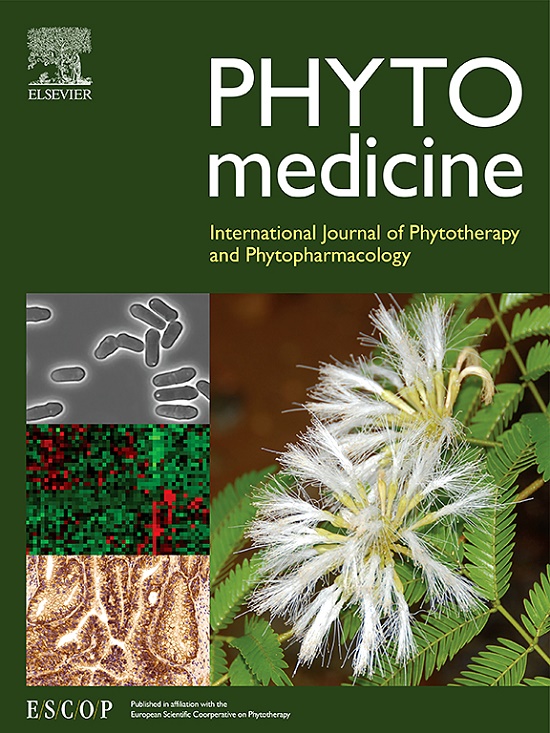甘草的抗大肠癌作用。通过高效液相色谱整合和网络药理学方法研究其潜在机制。
IF 6.7
1区 医学
Q1 CHEMISTRY, MEDICINAL
引用次数: 0
摘要
背景:结直肠癌(CRC)的治疗和预后结果仍然不令人满意。在已报道的多种甘草生物活性功能中。最近报道的一项重要活动是其对许多癌症的治疗作用,但有关其潜在关键机制和治疗活性成分的信息有限,特别是针对结直肠癌治疗。目的:探讨乌拉尔草治疗结直肠癌的药理基础和主要分子作用方式。方法:分别采用高效液相色谱(HPLC)和网络药理学(Network-pharmacology)分析技术,检测乌拉尔根有效成分,探讨其抗CRC作用机制,包括潜在的抗CRC植物化学物质、靶点和相关信号通路。而对于活性成分与靶标的结合能力,通过分子对接、分子动力学模拟技术和细胞增殖实验筛选了最佳的抗crc成分,并在SW480细胞上进行了生物学功能实验验证。最后,sw480 -异种移植模型及后续相关实验进一步证实了Liquiritin对CRC的作用。结果:高效液相色谱法从乌拉尔草中鉴定出7个化合物。网络药理学和分子对接结果表明,乌拉尔草成分具有显著的抗癌作用。这些作用是通过癌症和mapk相关信号通路介导的,靶向TP53、SRC、STAT3和PIK3CA蛋白。体外实验表明,与其他成分相比,甘草素具有更好的抗crc作用,可显著抑制SW480的繁殖、菌落发育、迁移和侵袭。此外,liquiritin已被证明可以通过靶向p53和抑制p38 MAPK通路显著减小荷瘤小鼠的肿瘤大小。结论:乌拉尔树的主要原料药为甘草素,通过抑制p53和p38 MAPK靶向结直肠癌的发生,可用于结直肠癌的治疗。这些发现为乌拉尔菌治疗结直肠癌提供了坚实的药理学基础和潜在的治疗靶点。本文章由计算机程序翻译,如有差异,请以英文原文为准。

Anti-colorectal cancer actions of Glycyrrhiza uralensis Fisch. and its underlying mechanism via HPLC integration and network pharmacological approaches
Background
The therapeutic and prognostic outcomes for colorectal cancer (CRC) remain unsatisfactory. Among multiple reported bioactive functionalities of Glycyrrhiza uralensis Fisch. one vital recently reported activity is its therapeutic role against numerous cancers but limited information is available related to its underlying key mechanisms and therapeutically active ingredients, especially against CRC treatment.
Objective
The aim of current study aims is to reconnoiter G. uralensis pharmacological basis and primary molecular mode of action in treating CRC.
Methods
For examining the G. uralensis active ingredients and underlying mechanism investigation against CRC including, potential anti-CRC phytochemicals, targets, and related signaling pathways, HPLC and Network-pharmacology analysis techniques was employed, respectively. Whereas, for binding capabilities of active components to their targets, molecular-docking, molecular dynamic simulation technique employed and cell proliferation assays screened the best anti-CRC components, followed by biological function experiments on SW480 cells for verification. Finally, the SW480-xenograft model and subsequent related experiments further confirmed the effect of Liquiritin on CRC.
Results
Seven compounds were identified from G. uralensis through HPLC. Network pharmacology and molecular docking results indicated that G. uralensis components exhibited significant anti-cancer effects. These effects were mediated through cancer and MAPK-related signaling pathways, targeting TP53, SRC, STAT3, and PIK3CA proteins. In-vitro experiments showed that liquiritin had better anti-CRC effects compared to other components as it significantly repressed the SW480 propagation, development of colony, relocation, and invasion. Additionally, liquiritin has been shown to significantly reduce tumor size in tumor-bearing mice by targeting p53 and inhibiting the p38 MAPK pathway.
Conclusion
In G. uralensis, main API is liquiritin that target CRC tumorigeneses via inhibition of p53 and p38 MAPK, thus can be used for CRC therapy. The findings provide a solid pharmacological basis and potential therapeutic targets for G. uralensis in the treatment of CRC.
求助全文
通过发布文献求助,成功后即可免费获取论文全文。
去求助
来源期刊

Phytomedicine
医学-药学
CiteScore
10.30
自引率
5.10%
发文量
670
审稿时长
91 days
期刊介绍:
Phytomedicine is a therapy-oriented journal that publishes innovative studies on the efficacy, safety, quality, and mechanisms of action of specified plant extracts, phytopharmaceuticals, and their isolated constituents. This includes clinical, pharmacological, pharmacokinetic, and toxicological studies of herbal medicinal products, preparations, and purified compounds with defined and consistent quality, ensuring reproducible pharmacological activity. Founded in 1994, Phytomedicine aims to focus and stimulate research in this field and establish internationally accepted scientific standards for pharmacological studies, proof of clinical efficacy, and safety of phytomedicines.
 求助内容:
求助内容: 应助结果提醒方式:
应助结果提醒方式:


